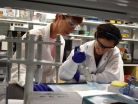(Press-News.org) Many physicians and advanced practice clinicians, including registered nurse practitioners, midwives and physician assistants, reported to work while being sick despite recognizing this could put patients at risk, according to the results of a small survey published online by JAMA Pediatrics.
Health-care associated infections can lead to substantial illness and death and excess costs. This is especially true for immunocompromised patients and others at high risk, including neonates. However, a gap in knowledge exists about the reasons why attending physicians and advanced practice clinicians (APCs) in the United States work while sick.
Julia E. Szymczak, Ph.D., of the Children's Hospital of Philadelphia, and coauthors administered an anonymous survey at the hospital to attending physicians and APCs, including certified registered nurse practitioners, physician assistants, clinical nurse specialists, certified registered nurse anesthetists and certified nurse midwives. They received responses from 280 attending physicians (61 percent) and 256 APCs (54.5 percent).
The survey found that while most respondents (504, 95.3 percent) believed that working while sick put patients at risk, 446 respondents (83.1 percent) reported working while sick at least once in the past year and 50 respondents (9.3 percent) reported working while sick at least five times. Survey respondents reported working with symptoms that included diarrhea, fever and the onset of significant respiratory symptoms.
The reasons why physicians and APCs reported working while sick included not wanting to let colleagues down (98.7 percent), staffing concerns (94.9 percent), not wanting to let patients down (92.5 percent), fear of being ostracized by colleagues (64 percent) and concerns about the continuity of care (63.8 percent).
An analysis of written comments about why respondents work while sick highlighted three areas: logistic challenges in identifying and arranging someone to cover their work and a lack of resources to accommodate sick leave; a strong cultural norm in the hospital to report for work unless one is extremely ill; and ambiguity about what symptoms constitute being too sick to work.
"The study illustrates the complex social and logistic factors that cause this behavior. These results may inform efforts to design systems at our hospital to provide support for attending physicians and APCs and help them make the right choice to keep their patients and colleagues safe while caring for themselves," the study concludes.
(JAMA Pediatr. Published online July 6, 2015. doi:10.1001/jamapediatrics.2015.0684. Available pre-embargo to the media at http://media.jamanetwork.com.)
Editor's Note: This study was supported by a cooperative agreement from the Center for Disease Control and Prevention. Please see article for additional information, including other authors, author contributions and affiliations, etc.
Editorial: When the Health Care Worker is Sick
In a related editorial, Jeffrey R. Starke, M.D., of the Baylor College of Medicine, Houston, and Mary Anne Jackson, M.D., University of Missouri-Kansas City School of Medicine, write: "Creating a safer and more equitable system of sick leave for HCWs [health care workers] requires a culture change in many institutions to decrease the stigma - internal and external - associated with HCW illness. Identifying solutions to prioritize patient safety must factor in workplace demands and variability in patient census and emphasize flexibility. ... Also essential is clarity from occupational health and infection control departments to identify what constitutes being too sick to work."
(JAMA Pediatr. Published online July 6, 2015. doi:10.1001/jamapediatrics.2015.0994. Available pre-embargo to the media at http://media.jamanetwork.com.)
Editor's Note: Please see article for additional information, including other authors, author contributions and affiliations, etc.
INFORMATION:
Media Advisory: To contact corresponding author Julia E. Szymczak, Ph.D., call Natalie Virgilio at 267-426-6246 or email virgilion@email.chop.edu. To contact corresponding editorial author Jeffrey R. Starke, M.D., call Glenna Vickers at 713-798-7973 or email picton@bcm.edu.
To place an electronic embedded link to this study in your story Links will be live at the embargo time: http://archpedi.jamanetwork.com/article.aspx?doi=10.1001/jamapediatrics.2015.0684 and http://archpedi.jamanetwork.com/article.aspx?doi=10.1001/jamapediatrics.2015.0994
A small fraction of pregnancies occur in women with epilepsy but a new study suggests those women may be at higher risk for complications and death during delivery, according to an article published online by JAMA Neurology.
Between 0.3 percent and 0.5 percent of all pregnancies occur in women with epilepsy. However, there is inadequate data on obstetrical outcomes so the risk of adverse outcomes and death in this population of women remains largely unquantified.
Sarah C. MacDonald, B.Sc., of the Harvard T.H. Chan School of Public Health, Boston, and coauthors looked ...
Cognitive behavioral therapy is a widely used nonpharmacologic treatment for insomnia disorders and an analysis of the medical literature suggests it also can work for patients whose insomnia is coupled with psychiatric and medical conditions, according to an article published online by JAMA Internal Medicine.
Previous meta-analyses have suggested that cognitive behavioral therapy for insomnia can improve sleep, although many of these studies excluded individuals with co-existing psychiatric and medical conditions.
Jason C. Ong, Ph.D., of Rush University Medical Center, ...
MADISON - The newfound ability of a protein of the intestines and lungs to distinguish between human cells and the cells of bacterial invaders could underpin new strategies to fight infections.
Writing this week (July 6, 2015) in the journal Nature Structural and Molecular Biology, a team led by University of Wisconsin-Madison Professor Laura Kiessling describes the knack of a human protein known as intelectin to distinguish between our cells and those of the disease-causing microbes that invade our bodies.
"This has the potential to change the game in terms of how ...
Studying brain scans and cerebrospinal fluid of healthy adults, scientists have shown that changes in key biomarkers of Alzheimer's disease during midlife may help identify those who will develop dementia years later, according to new research.
The study, at Washington University School of Medicine in St. Louis, is published July 6 in JAMA Neurology.
"It's too early to use these biomarkers to definitively predict whether individual patients will develop Alzheimer's disease, but we're working toward that goal," said senior author Anne Fagan, PhD, a professor of neurology. ...
A blood-borne molecule that increases in abundance as we age blocks regeneration of brain cells and promotes cognitive decline, suggests a new study by researchers at UC San Francisco and Stanford School of Medicine.
The molecule in question, known as beta-2 microglobulin, or B2M, is a component of a larger molecule called MHC I (major histocompatibility complex class I), which plays a major role in the adaptive immune system. A growing body of research indicates that the B2M-MHC I complex, which is present in all cells in the body except red blood cells and plasma cells, ...
What gives plastic objects their flexibility and reduces their brittleness is the concentration of plasticiser. For example, a chemical solvent of the phthalate family called DOP is often used. The trouble is there are concerns that phthalates present health risks. So there is a demand for more alternatives. Now, scientists from China have examined the effect of using DEHHP, a new eco-friendly plasticiser, used in combination with PVC. For a plasticiser to work, there has to be adequate hydrogen bonding with the plastic. By combining experiments and simulations, the team ...
Nearly 800 million people worldwide don't have access to safe drinking water, and some 2.5 billion people live in precariously unsanitary conditions, according to the Centers for Disease Control and Prevention. Together, unsafe drinking water and the inadequate supply of water for hygiene purposes contribute to almost 90% of all deaths from diarrheal diseases -- and effective water sanitation interventions are still challenging scientists and engineers.
A new study published in Nature Nanotechnology proposes a novel nanotechnology-based strategy to improve water filtration. ...
Optogenetics techniques, which allow scientists to map and control nerve cells using light stimulation, are being used to study neural circuits in the brain with unprecedented precision. This revolutionary technology relies on light-sensitive proteins such as channelrhodopsins, and researchers at UC Santa Cruz have now determined the molecular mechanism involved in the light-induced activation of one of these proteins.
The new findings, published July 3 in two papers in the Journal of Biological Chemistry, can help scientists create tailor-made proteins optimized for ...
Evolutionary change in a gene resurrected in the lab from the extinct woolly mammoth altered the gene's temperature sensitivity and likely was part of a suite of adaptations that allowed the mammoth to survive in harsh arctic environments, according to new research. In a study published in Cell Reports on July 2, 2015, researchers determined the whole-genome sequence of two woolly mammoths and three modern Asian elephants, predicted the function of genetic changes found only in the mammoths, and then experimentally validated the function of a woolly mammoth gene reconstructed ...
An international team, led by a University of Adelaide genetics expert, has made a breakthrough discovery which is expected to help thousands of young girls worldwide who are suffering from a rare yet debilitating form of epilepsy.
Professor Jozef Gecz, from the University of Adelaide's Robinson Research Institute, was a key player in identifying the responsible gene and mutations in this female-only epileptic syndrome, in 2008.
In breakthrough research published in Oxford Journals, Human Molecular Genetics, Professor Gecz has now found a treatment for this disorder. ...

